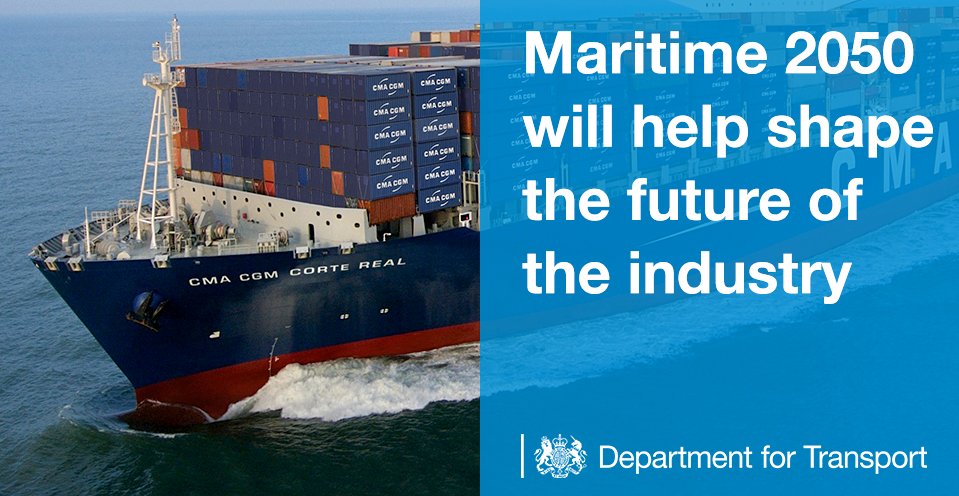|
S1 TACKLING EMISSIONS - CLEAN MARITIME PLAN 2050
Please use our A-Z INDEX to navigate this site or return HOME
|
|
Chris Grayling and Nus Ghani
15. The UK’s maritime sector is substantial. There are 51 major ports in the UK, which together handled just under half a billion tonnes of commercial cargo13 and over 22 million passengers [14] in 2017. This accounts for around 95% of UK trade. The maritime sector directly contributes £14.5 billion Gross Value Added (GVA) to the UK’s economy a year and directly employs 185,700 people [15]. If taken as a group, the Red Ensign Group16 would have the 10th largest registered trading fleet in the world at the end of 2018, totalling 59.6 million deadweight tonnage [17].
16. The UK also enjoys a globally significant maritime tourism and leisure industry. Total revenue from the UK’s leisure, superyacht and small commercial marine industry was put at £3.12 billion in 2017 with export success counting for just over 30% of the sector’s total revenue. Our cruise sector is an exciting and fast growing one with 1.96 million cruises sold in the UK in 2017, half of which started at a British port [18].
17. The UK’s maritime services sector is also significant. Maritime business services directly contribute £2 billion GVA to the UK economy. When impacts on the wider economy are accounted for, including the rest of the maritime sector, this rises to nearly £5 billion. The City of London is a global leader in this area; the largest share of worldwide marine insurance premiums and ship-broking transactions occur in the UK, comprising 35% and 26% of the global market respectively [19].
18. Like other important sectors of the economy, the maritime sector is increasingly aware of its environmental and social impacts. As set out in Maritime 2050, the impacts of the sector in terms of emissions to air – in the form of both air quality pollutants and greenhouse gases – require attention.
Air Quality Pollutants
19. Air pollution is a major public health risk ranking alongside cancer, heart disease and obesity, and poses the single greatest environmental risk to human health in the UK. This underlines the importance of the recently published UK Clean Air Strategy (CAS)20. Recent research commissioned by Public Health England has found that the health and social care costs of air pollution in England could reach £5.3 billion by 203521. Certain air quality pollutants such as nitrogen oxides are also known to affect biodiversity22. The CAS, published in January 2019, outlined how actions to reduce emissions of 5 key pollutants could cut the costs of air pollution to society by £1 billion every year by 2020, rising to £2.5 billion every year from 2030 [23].
20. Our understanding of the evidence on air
quality pollutant emissions from shipping and wider port activity is growing
rapidly. The latest evidence shows that shipping generates emissions to air of several
pollutants harmful to human health:
25. However, a recent analysis carried out by Imperial College, using Automated Identification System (AIS) data26 showed that, in 2016, NOx emissions from UK international shipping and shipping in transit were three and six times higher respectively than for UK domestic shipping, and so have a more significant impact on air quality in the UK.
21. The fuel used for shipping has historically been some of the most polluting fuel used across all transport modes. The introduction of Emission Control Areas (ECA) has helped limit the sulphur content of maritime oil but this is still typically an order of magnitude higher in these fuels than in those used in, for instance, road vehicles [27].
22. To date, domestic policy on transport related air pollutant emissions has largely focused on roads (particularly in relation to nitrogen dioxide concentration). As a result, average levels of nitrogen dioxide at the roadside are at their lowest level since the Government first started to collect these statistics [28]. As emissions from road transport begin to decrease because of significant mitigating intervention – as set out in the Government’s Road to Zero Strategy [29] – the contribution of relatively smaller sources of air pollution, including the maritime sector, will increase.
Greenhouse Gases
23. In terms of CO2 emissions, shipping is considered one of the most efficient modes of transport [30]. However, it also represents a substantial source of GHG emissions.
24. The most recent study by the IMO estimates that international shipping accounted for 2.2% of global CO2 emissions in 2012 [31]. This is equivalent to the total emissions of Germany, the world’s 4th biggest economy32. If no further action is taken then estimates from the IMO suggest that the CO2 emissions from international shipping could grow by between 50% and 250% by 205033, and a study for the European Parliament suggests that international shipping could account for 17% of global CO2 emissions by 2050 [34].
25. The UK does of course contribute to these global maritime GHG emissions, both through international shipping calling at UK ports35 and UK domestic shipping. UK domestic shipping accounted for 5.9Mt of CO2 equivalent in 2017, equating to 1% of all domestic emissions. Domestic and international shipping together were responsible for 13.87Mt of CO2 equivalent in 2017 [36].
26. As a percentage of the UK’s overall GHG emissions, shipping’s contribution (both international and domestic) is 3.4%37. As emissions from other parts of the economy decrease in line with UK commitments and action on climate change, the contribution of relatively smaller sources of GHGs, including the maritime sector, will increase. Existing Emission Policy Air Quality Pollutants
27. There are limited regulations or policies in the UK specifically to incentivise reductions of air pollution from shipping. To date, the UK’s main priority in tackling ship emissions has been exerting influence at an international level.
28. Air pollution from shipping is regulated
by the IMO through the International Convention for the Prevention of Pollution
from Ships (MARPOL). Annex VI of MARPOL entered into force in 2005, with,
among other things, the aim of minimising airborne emissions from ships. As well as
overarching European Directives on ambient air quality [38], the European
Commission has also introduced specific Regulations for progressively integrating maritime emissions
into the EU’s policy for reducing its domestic GHG and pollutant
emissions [39].
30. In 2016 it was agreed at the IMO that the North Sea would become a NOx ECA. This will enter into force on 1 January 2021 and will require new-build ships delivered after that date to operate against the IMO’s ‘Tier III’ (most stringent) NOx control standards. In practical terms, this means that new ships operating in these waters will need to reduce their NOx emissions by around three-quarters. This represents significant progress, and the industry has invested in new technologies like exhaust gas cleaning systems and liquefied natural gas (LNG) as a fuel to meet these new limits.
31. In 2008, Member States at the IMO agreed to a 0.5% sulphur limit for global shipping outside emission control areas (ECAs) from 2020 (subject to a review on fuel availability), a reduction of three percentage points from the current limit. This decision was confirmed in 2016 at the IMO’s Marine Environment Protection Committee (MEPC). The UK continues to co-operate closely with other Member States at the IMO on detailed technical and operational matters related to the introduction of the 0.5% sulphur cap. The IMO is making good progress, and we are confident outstanding issues will be resolved before the implementation date.
32. At a domestic level, the Government’s Clean Air Strategy (CAS)40, which was published in January 2019, sets an ambitious and holistic approach to improve air quality and reduce emissions of air pollutants across all sectors, including the maritime sector. The CAS was designed to deliver the emission reductions needed to achieve emission ceilings in 2020 and 2030, halving the impacts of air pollution on human health and the environment. In the CAS, the Government committed to developing the Clean Maritime Plan, alongside a Clean Maritime Council to inform the development and implementation of the Plan. Also in the CAS, Government committed to publish in 2019:
● A Call for Evidence to explore options for standardising environmental regulations for vessels operating domestically within the UK, including inland waterways.
● A consultation on options for extending the North Sea Emissions Control Area beyond its current geographical limits or establishing new, geographically distinct, Emissions Control Areas around the UK coast.
● Guidelines to advise ports on how to develop effective and targeted Air Quality Plans.
33. Further detail on these commitments is set out below.
Greenhouse Gases
34. In relation to greenhouse gases, at an international level, the UK has recently been at the forefront of pushing for an ambitious strategy to reduce GHGs from shipping at the IMO41. In April 2018, Member States at the IMO agreed in this strategy a commitment to phasing out GHG emissions from shipping as soon as possible in this century and reducing GHGs by at least 50% compared to 2008 by 2050. This commitment from the IMO sends a strong signal to the whole shipping sector on the need for investment in the development of low- and zero-carbon fuels and innovative energy-efficient technologies. Member States of the IMO are working now to develop detailed measures which will ensure the 2050 target is attained.
35. Domestic policy relating to emissions of GHGs from the maritime sector is based around the Climate Change Act 2008, under which the Government sets five yearly carbon budgets which currently run until 2032. These restrict the amount of GHGs the UK can legally emit in a five-year period.
36. Emissions from domestic shipping are included in both the carbon budgets and the 2050 target. Although emissions from international shipping are not currently included in the UK’s targets under the Climate Change Act 2008, our carbon budgets put the UK on a trajectory consistent with a 2050 target which includes these emissions. While this national policy sets the context for national targets on emissions, there are currently no specific sectoral targets in place for UK domestic or international shipping emissions. Likewise, Government has not yet formally accepted any planning assumption for international shipping emissions. Further consideration of the UK’s national GHG reduction targets, and the question of international shipping’s inclusion therein, is set out below (see ‘The Role of Targets’).
37. On a smaller scale than sector-wide targets, there are certain domestic policies which encourage the uptake of zero emission shipping, most notably the Renewable Transport Fuel Obligation (RTFO). As well as applying to the road sector (on a mandatory basis) and aviation sector (on an optional basis), the RTFO currently applies to fuel suppliers for the non-road mobile machinery (NRMM) sectors, the definition of which includes inland shipping and recreational craft that do not normally operate at sea.
Clean Growth Opportunities for
the UK
41. Markets for many of the technologies in Figure 2 are largely nascent at present, with uptake of low emission shipping technologies primarily centred on a wide array of energy efficiency or exhaust cleaning systems. Given the early stage of development of these markets, there remain opportunities for countries to build up expertise or dominance in wide parts of the zero-emission shipping supply chain.
42. Figure 3
identifies a number of areas in the UK which have the potential to act as demand or supply hubs for low- or
zero emission propulsion options. These areas are based on preliminary research
undertaken for the Clean Maritime Plan. Further work is required to identify potential
UK geographical clusters for clean maritime technologies.
46. Figure 4 visualises the estimates of the potential annual global market size for the different maritime emission reduction options assessed in the research.
47. More specifically, the research identified hydrogen and ammonia production technologies as offering the most significant potential economic benefits to the UK. The reasoning for this was as follows:
● Hydrogen production technologies: “The UK is well placed in relation to hydrogen production technologies. The UK’s extensive experience in natural gas and reformer technologies would be a key advantage here. In addition, the UK is already a world leader in electrolysis activities (prompting the EU's Fuel Cell Hydrogen Joint Undertaking [FCH-JU]), which are directly relevant to hydrogen production for zero emission shipping. It is estimated that the UK currently has around a 9% global export market share of reformer and CCS technologies, which are likely to be important elements of hydrogen production for zero emission shipping. Both China and the USA currently have market shares in excess of 10% in this area.” There is currently no take-up of hydrogen fuel in the global fleet. If policies and incentives are in place to move towards zero emission shipping by the middle of the century, hydrogen fuel usage may increase or remain low depending on future cost effectiveness. However, hydrogen production technologies are an important input to ammonia and in some cases methanol fuel which may have substantial expected take-up.
● Ammonia production technologies: The UK also has a strong competitive position in relation to ammonia production technologies. In particular, the UK has a strong domestic position for ammonia catalyst supply, and ammonia-based fertiliser is produced in volume in the UK. This is important because catalyst supply is a high-value part of the supply chain. The current take-up of onboard ammonia fuel technologies is relatively low so this is a nascent market at present.”
The Clean Maritime Plan: A Route Map
48. Recognising the international imperative to move to zero emission shipping, the need to have a holistic approach to tackling all forms of maritime emissions to air, and the potential economic opportunities associated with the global transition to alternative propulsion, Maritime 2050 articulated the Government’s ambition to actively drive the transition to zero emission shipping in its waters, as follows. “In 2050, zero emission ships are commonplace globally. The UK has taken a proactive role in driving the transition to zero emission shipping in UK waters and is seen globally as a role model in this field, moving faster than other countries and faster than international standards. As a result, the UK has successfully captured a significant share of the economic, environmental and health benefits associated with this transition.”
49. Maritime 2050’s environment chapter outlines the need for a co-ordinated approach across government, industry and academia to reach this vision. It recognised the following principles as a foundation for achieving this vision.
● Move quickly: the need for action to reduce the environmental impacts of the maritime sector is urgent and the transition must take place rapidly.
● Be bold: the UK will lead by example, positioning itself as a world leader in thinking and action on minimising environmental impacts of the maritime sector.
● Play to our strengths: prioritise interventions which benefit the UK, addressing market failures and amplifying investment in areas where the UK has potential comparative strengths.
● Reduce business risk: give consistent and strong support for investment in the transition to green shipping. Deliver proportionate, well-evidenced regulation, while maintaining a level playing field.
● Be innovative: in line with the government’s commitment to raise spending on R&D, increase support for innovation throughout the maritime technology life-cycle.
● Take a systems approach: policies should consider the whole supply chain, including infrastructure and linkages with other sectors of the economy (e.g. power networks and hydrogen supply).
● Collaborate: government, industry and academia need to work more closely together and form lasting partnerships.
50. The Clean Maritime Plan is a national action
plan to drive the UK towards the vision for zero emission shipping. Shaped
by the principles above, it sets out a pathway which encourages fast, bold action, playing
to the UK’s competitive advantages. It aims to assist in giving business certainty over
the future policy landscape, and seeks to shape public interventions bearing
in mind the need for a systems approach. The Plan seeks to support innovation in the
maritime sector and is underpinned by a collaborative approach, having been guided
by extensive consultation, research and advice from industry through, for
instance, the Clean Maritime Council.
SECTION 1 - TACKLING EMISSIONS:
14
- 50
The
Knowledge Transfer Network is Innovate UK’s network partner, and also provides innovation networking for other funders in line with its mission to drive UK growth.
Grant Shapps - Secretary of State for Transport 2021
LINKS & REFERENCE
https://
Please use our A-Z INDEX to navigate this site
|
|
|
This website is Copyright © 2021 Jameson Hunter Ltd
|



